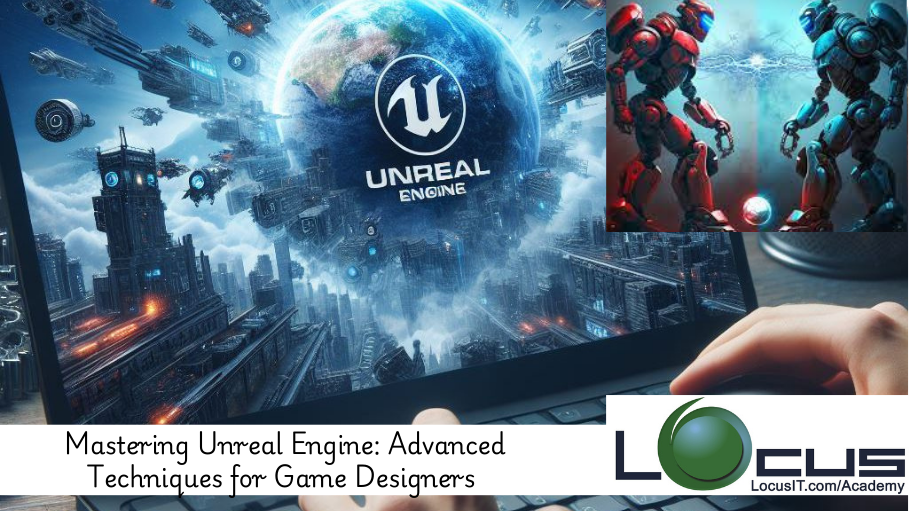Description
Introduction
Unreal Engine for Game Designers skills to the next level with this advanced course tailored for experienced game designers. This training focuses on cutting-edge techniques and best practices to help you create more complex, polished, and performance-optimized games. From advanced visual scripting and physics to multiplayer integration and rendering optimization, you’ll gain the expertise needed to tackle high-level game development challenges.
Prerequisites
- Proficiency with Unreal Engine basics, including Blueprints and level design.
- Familiarity with game design principles and workflows.
- Experience with 3D modeling, materials, and asset management.
- Basic knowledge of programming (C++ is a plus).
Table of Contents
- Advanced Blueprint Techniques
1.1 Custom Blueprint functions and macros.
1.2 Advanced event handling and flow control.
1.3 Building reusable Blueprint components.
1.4 Optimizing Blueprints for performance. - C++ Programming in Unreal Engine
2.1 Introduction to Unreal Engine’s C++ API.
2.2 Creating custom game mechanics with C++.
2.3 Extending Blueprints with C++ functionality.
2.4 Debugging and profiling C++ code in Unreal Engine. - Dynamic Lighting and Rendering
3.1 Advanced lighting techniques.
3.2 Global illumination and ray tracing.
3.3 Material instancing and shader optimization.
3.4 Post-processing effects and cinematic visuals. - Animation Mastery
4.1 Using the animation blueprint.
4.2 Advanced character rigging and IK setups.
4.3 Blending animations for complex behaviors.
4.4 Working with motion capture data. - Physics and Destruction
5.1 Implementing advanced physics simulations.
5.2 Working with Unreal Engine’s Chaos Physics system.
5.3 Creating destructible environments.
5.4 Optimizing physics for real-time performance. - Multiplayer Game Development
6.1 Understanding Unreal Engine’s networking architecture.
6.2 Setting up multiplayer lobbies and matchmaking.
6.3 Synchronizing gameplay across clients.
6.4 Troubleshooting and optimizing multiplayer performance. - AI and Gameplay Systems
7.1 Building intelligent NPCs with behavior trees.
7.2 Designing complex decision-making systems.
7.3 Implementing pathfinding and navigation.
7.4 AI testing and debugging techniques. - Level Design and Optimization
8.1 Creating large-scale open worlds.
8.2 Managing level streaming and LOD systems.
8.3 Performance optimization for high-detail levels.
8.4 World-building tips for immersive gameplay. - Custom Tools and Plugins
9.1 Developing editor tools to streamline workflows.
9.2 Creating custom Unreal Engine plugins.(Ref: Unreal Engine Fundamentals: Introduction to Game Development)
9.3 Sharing and integrating tools with teams.
9.4 Case studies: Tool development in action. - Unreal Engine for Virtual Reality (VR) and Augmented Reality (AR)
10.1 Building VR-ready experiences.
10.2 Designing AR interactions with Unreal Engine.
10.3 Optimizing for VR and AR platforms.
10.4 Troubleshooting VR/AR development challenges. - Optimization and Debugging
11.1 Advanced performance profiling tools.
11.2 Memory management and garbage collection.
11.3 Reducing draw calls and improving FPS.
11.4 Troubleshooting common performance bottlenecks. - Unreal Engine Ecosystem and Integration
12.1 Working with third-party plugins and tools.
12.2 Integrating external APIs and services.
12.3 Unreal Engine with external rendering tools.
12.4 Cross-platform deployment strategies.
Conclusion
This advanced Unreal Engine course empowers game designers to push the boundaries of their creativity and technical expertise. With these high-level techniques, you’ll be prepared to tackle ambitious game projects and deliver exceptional gaming experiences. Stay curious and innovate as you continue mastering Unreal Engine.







Reviews
There are no reviews yet.